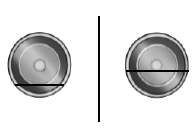Driving through water
WARNING: Drive through water in an emergency only, and not as part of normal driving.
WARNING: Engine damage can occur if water enters the air filter.
Note: Driving through deep water may allow water into the transmission or air intake and can cause internal vehicle damage or cause it to stall.
Note: Once through the water, always dry the brakes by moving your vehicle slowly while applying light pressure on the brake pedal.
If driving through deep or standing water is unavoidable, proceed very slowly. Never drive through water that is higher than the bottom of the wheel rims (for cars) or the bottom of the hubs (for trucks).

When driving through water, traction or brake capability may be limited. Also, water may enter your engine’s air intake and severely damage your engine or your vehicle may stall.
Wet brakes do not stop the vehicle as quickly as dry brakes.
See also:
Export unique (non–United States/Canada) vehiclespecific information
For your particular global region, your vehicle may be equipped with features
and options that are different from the features and options that are described
in this owner’s manual. A market uni ...
Head restraints
WARNING: To minimize the risk of neck injury in the event of a crash,
the driver and passenger occupants should not sit in or operate the vehicle, until
the head restraint is placed in its proper ...
Symbol glossary
WARNING: You risk death or serious injury to yourself and others if you
do not follow the instruction highlighted by the warning symbol.
These are some of the symbols you may see on your vehicle.
...
